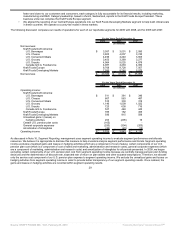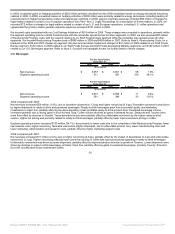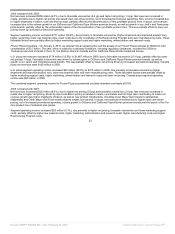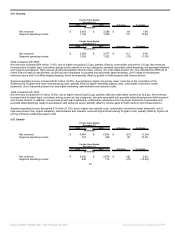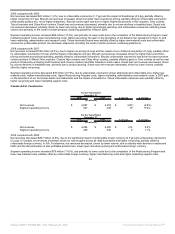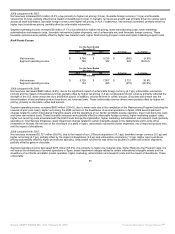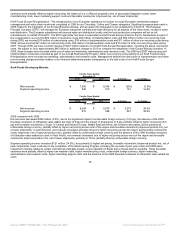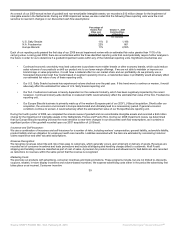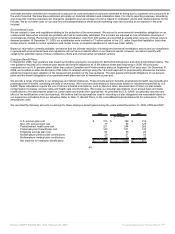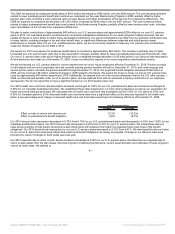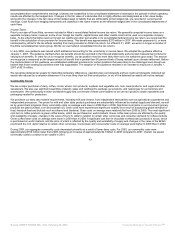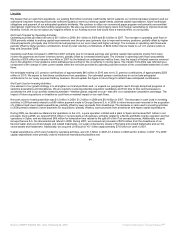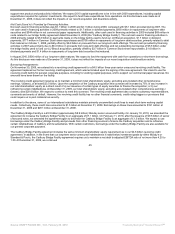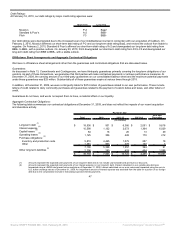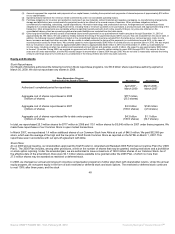Kraft 2009 Annual Report Download - page 41
Download and view the complete annual report
Please find page 41 of the 2009 Kraft annual report below. You can navigate through the pages in the report by either clicking on the pages listed below, or by using the keyword search tool below to find specific information within the annual report.
historical experience and other assumptions that we believe are reasonable. If actual amounts differ from estimates, we include the revisions in
our consolidated results of operations in the period in which we know the actual amounts. Historically, the aggregate differences, if any, between
our estimates and actual amounts in any year have not had a significant impact on our consolidated financial statements.
Inventories:
Inventories are stated at the lower of cost or market. We record inventory allowances for overstocked and obsolete inventories due to ingredient
and packaging changes. Effective January 1, 2009, we changed our method of valuing our U.S. inventories to the average cost method. In prior
years, principally all U.S. inventories were valued using the last-in, first-out (“LIFO”) method. We believe that the average cost method of
accounting for U.S. inventories is preferable and will improve financial reporting by better matching revenues and expenses to current costs, by
better aligning our external reporting with our competitors, and by aligning our external reporting with our tax basis of accounting. The financial
statements for all periods presented were conformed to the change in accounting policy. With this change, we value all of our inventories using the
average cost method.
Refer to Note 1, Summary of Significant Accounting Policies, to the consolidated financial statements for further details of this change in
accounting policy.
Long-Lived Assets:
We review long-lived assets, including amortizable intangible assets, for impairment when conditions exist that indicate the carrying amount of the
assets may not be fully recoverable. We perform undiscounted operating cash flow analyses to determine if an impairment exists. When testing
assets held for use for impairment, we group assets and liabilities at the lowest level for which cash flows are separately identifiable. If an
impairment is determined to exist, the loss is calculated based on estimated fair value. Impairment losses on assets to be disposed of, if any, are
based on the estimated proceeds to be received, less costs of disposal.
Goodwill and Intangible Assets:
We test goodwill and non-amortizable intangible assets at least annually for impairment. We have recognized goodwill in our reporting units, which
are generally one level below our operating segments. We use a two step process to test goodwill at the reporting unit level. The first step involves
a comparison of the estimated fair value of each reporting unit with its carrying value. Fair value is estimated using discounted cash flows of the
reporting unit based on planned growth rates, and estimates of discount rates and residual values. If the carrying value exceeds the fair value, the
second step of the process is necessary. The second step measures the difference between the carrying value and implied fair value of goodwill.
To test non-amortizable intangible assets for impairment, we compare the fair value of the intangible asset with its carrying value. Fair value of
non-amortizable intangible assets is determined using our planned growth rates, and estimates of discount rates and royalty rates. If the carrying
value exceeds fair value, the intangible asset is considered impaired and is reduced to fair value. Definite-lived intangible assets are amortized
over their estimated useful lives.
We perform our annual impairment review of goodwill and non-amortizable intangible assets as of October 1 each year. The basis of our valuation
methodology for estimating the fair value of our 20 reporting units is a 20-year projection of discounted cash flows that is based on our annual
strategic planning process. Estimating the fair value of individual reporting units requires us to make assumptions and estimates regarding our
future plans, industry and economic conditions. For our reporting units within our Kraft Foods North America and Kraft Foods Europe geographic
units, we used a market-participant, weighted-average cost of capital of 7.5% to discount the projected cash flows of those operations. For our
reporting units within our Kraft Foods Developing Markets geographic unit, we used a risk-rated discount rate of 10.5%.
38
Source: KRAFT FOODS INC, 10-K, February 25, 2010 Powered by Morningstar® Document Research℠



